Fine Coins Showcase
Antiquities Showcase
Hide empty categories
Shop Search
Shopping Cart
My FORVM
Contact Us
About Forum
Shopping at Forum
Our Guarantee
Payment Options
Shipping Options & Fees
Privacy & Security
Forum Staff
Selling Your Coins
Identifying Your Coin
FAQs
zoom.asp
Home ▸ Catalog ▸ |Greek Coins| ▸ |Geographic - All Periods| ▸ |Anatolia| ▸ |Lydia| ▸ |Saitta||View Options:   | | | | | | Saitta (or Saittai) was in eastern Lydia, in the triangle between the upper Hyllus river (modern Demirci Çayı) and the Hermus river (modern Sidaskale). Representations of the river gods are found on coins of the Imperial Period. The moon god Mên Akziottenos was honored, but Zeus, Dionysos, Aphrodite, Hygieia, Asklepios, Apollo, Kybele, and Herakles were also revered at Saitta. The town was a regional center for textile production. Hadrian probably visited in 124 A.D. In the city, In the Christian era Saittai was attached to the Archbishopric of Sardeis. |


Wandering the world in a panther-drawn chariot, Dionysus rode ahead of the maenads and satyrs, who sang loudly and danced, flushed with wine. They were profusely garlanded with ivy and held the thyrsus, a staff topped with a pine-cone, a symbol of the immortality of his believers. Everywhere he went he taught men how to cultivate vines, and the mysteries of his cult. Whoever stood in his way and refused to revere him was punished with madness.RP27249. Bronze AE 17, GRPC Lydia 62; RPC Online III 2544; SNGvA 62; SNG Righetti 1067; Waddington 5172; Imhoof LS p. 128, 4; BMC Lydia -; SNG Cop -, F, weight 4.143 g, maximum diameter 17.1 mm, die axis 180o, Saitta (Sidaskale, Turkey) mint, 128 - c. 136 A.D.; obverse CEBACTH CABEINA, draped bust bust right, wearing stephane; reverse CAITTHNΩN, Dionysos standing left holding kantharos and thyrsus, panther at feet; very rare; SOLD
Saitta, Lydia, c. 200 - 275 A.D.
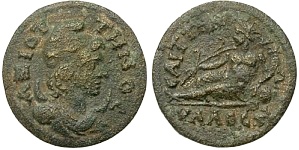

Luna, the Greek moon-goddess, was female, which seems natural because the female menstrual cycle follows the lunar month. But Mên was a male moon-god, probably originally of the indigenous non-Greek Karian people. By Roman times Mên was worshiped across Anatolia and in Attica. He was associated with fertility, healing, and punishment. Mên is usually depicted with a crescent moon behind his shoulders, wearing a Phrygian cap, and holding a lance or sword in one hand and a pine-cone or patera in the other. His other attributes include the bucranium and chicken. A temple of Mên has been excavated at Antioch, Pisidia.RP82017. Bronze AE 20, GRPC Lydia 40; SNG Cop 396; BMC Lydia p. 216, 24; Imhoof LS 2, VF, weight 4.056 g, maximum diameter 20.1 mm, die axis 180o, Saitta (Sidaskale, Turkey) mint, c. 200 - 275 A.D.; obverse AZIOTTHNOC, draped bust of Mên Aziottenos, wearing Phrygian cap, crescent behind; reverse CAITTHNΩN YΛΛOC, river-god Hyllos reclining left, holding reed and cornucopia, resting elbow on inverted vase from which water flows; SOLD
Tranquillina, Augusta May 241 - 25 February 244 A.D., Saitta, Lydia
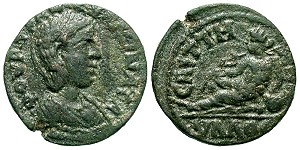

Saitta (or Saittai) was in eastern Lydia, in the triangle between the upper Hyllus river (modern Demirci Çayi) and the Hermus river (modern Sidaskale). Representations of the river gods are found on coins of the Imperial Period. The moon god Mên Akziottenos was honored, but Zeus, Dionysos, Aphrodite, Hygieia, Asklepios, Apollo, Kybele, and Herakles were also revered at Saitta. The town was a regional center for textile production. Hadrian probably visited in 124 A.D. In the city, In the Christian era Saittai was attached to the Archbishopric of Sardeis.RP05043. Bronze AE 22, GRPC Lydia p. 262, 154; RPC Online VII 20-22; SNGvA 3104, SNG Cop 412; SNG Mun 448; SNG Righetti 1071; SNG Leypold I 1173; BMC Lydia p. 224, 63, VF, weight 6.26 g, maximum diameter 21.7 mm, die axis 180o, Saitta (Sidaskale, Turkey) mint, May 241 - 25 Feb 244 A.D.; obverse ΦOYP TPANKYΛΛEINA CA, diademed and draped bust right; reverse CAITTHNΩN, YΛΛOC (in ex), river-god Hyllos reclining left, holding reed and resting on urn from which water flows; SOLD
Otacilia Severa, Augusta, February or March 244 - September or October 249 A.D., Saitta, Lydia
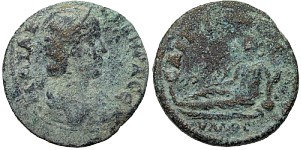

Saitta (or Saittai) was in eastern Lydia, in the triangle between the upper Hyllus river (modern Demirci Çayi) and the Hermus river (modern Sidaskale). Representations of the river gods are found on coins of the Imperial Period. The moon god Mên Akziottenos was honored, but Zeus, Dionysos, Aphrodite, Hygieia, Asklepios, Apollo, Kybele, and Herakles were also revered at Saitta. The town was a regional center for textile production. Hadrian probably visited in 124 A.D. In the city, In the Christian era Saittai was attached to the Archbishopric of Sardeis.RP27260. Bronze AE 22, GRPC Lydia p. 280, 159; SNG Righetti 1073; BMC Lydia p. 225, 67; Waddington 5196; SNG Cop -, aVF, weight 4.645 g, maximum diameter 21.9 mm, die axis 180o, Saitta (Sidaskale, Turkey) mint, Feb/Mar 244 - Sep/Oct 249 A.D.; obverse M ΩTAK CEBHPA CE, diademed and draped bust right, wearing stephane; reverse CAITTHNΩN YΛΛOC, river-god Hyllos reclining left, reed in right hand, emptying vase of water with left hand; rare; SOLD
Tranquillina, Augusta, May 241 - 25 February 244 A.D., Saitta, Lydia
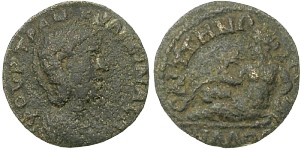

Saitta (or Saittai) was in eastern Lydia, in the triangle between the upper Hyllus river (modern Demirci Çayı) and the Hermus river (modern Sidaskale). Representations of the river gods are found on coins of the Imperial Period. The moon god Mên Akziottenos was honored, but Zeus, Dionysos, Aphrodite, Hygieia, Asklepios, Apollo, Kybele, and Herakles were also revered at Saitta. The town was a regional center for textile production. Hadrian probably visited in 124 A.D. In the city, In the Christian era Saittai was attached to the Archbishopric of Sardeis.RP82137. Bronze AE 21, BMC Lydia p. 224, 63; GRPC Lydia p. 262, 154; RPC Online VII 20-22; SNGvA 3104, SNG Cop 412; SNG Mun 448; SNG Righetti 1071; SNG Leypold I 1173, F, weight 4.195 g, maximum diameter 20.6 mm, die axis 180o, Saitta (Sidaskale, Turkey) mint, May 241 - 25 Feb 244 A.D.; obverse ΦOYP TPAN-KYΛΛEINA CA, diademed and draped bust right; reverse CAITTHNΩ-N, YΛΛOC (in exergue), river-god Hyllos reclining left, reeds in right hand, resting left arm on urn from which water flows; SOLD
Saitta, Lydia, c. 198 - 222 A.D.


In Greek mythology, Hyllos was the eldest son of Herakles and his wife Deianira. Heracles had an affair with the younger and more beautiful Iole. Years earlier, the centaur Nessus had attempted to rape Deianira. Herakles saved her by shooting Nessus with poisoned arrows. The centaur told her in his dying breath that if she were to give Herakles a cloak soaked in his blood, it would be a love charm. Deianira, believed him and saved some of Nessus' blood. Worried by Herakles' infidelity, she gave Herakles a blood soaked cloak, but Nessus' blood was deadly poison. Upon realizing she had unwittingly poisoned her husband, Deianira killed herself. Before Herakles died, because of his love for Iole, he asked his eldest son, Hyllus to marry her so that she would be well cared for. Iole and Hyllus had a son called Cleodaeus, and three daughters, Evaechme, Aristaechme, and Hyllis.RP110433. Bronze AE 22, GRPC Lydia 39; RPC Online VI T4428; BMC Lydia p. 216, 24; SNG Cop 396; SNGvA 3089; Winterthur 3884; Hochard 1795, aVF, broad flan, strike a little flat, areas of corrosion, light earthen deposits, scratches, weight 5.719 g, maximum diameter 21.7 mm, die axis 0o, Saitta (Sidaskale, Turkey) mint, c. 198 - 222 A.D.; obverse AZIOTTHNOC, draped bust of Mên Aziottenos right, wearing Phrygian cap, crescent behind shoulders; reverse CAITTHNΩN / YΛΛOC, river-god Hyllos reclining left, reed in right hand, cornucopia in left hand, resting elbow on inverted vase from which water flows; SOLD
Gallienus, August 253 - September 268 A.D., Saitta, Lydia
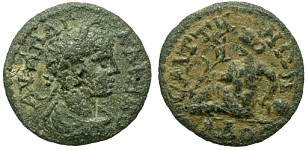

RP19846. Bronze AE 19, GRPC Lydia p. 282, 168; SNG Cop 415; SNG Lewis 1534; Winsemann 2641; Mionnet IV 627; BMC Lydia -; Lindgren -, VF, a few small deep pits on the obverse appear to be pre-strike flan flaws, weight 3.238 g, maximum diameter 19.3 mm, die axis 0o, Saitta (Sidaskale, Turkey) mint, Aug 253 - Sep 268 A.D.; obverse AY K Π Λ ΓAΛΛIHNOC, laureate, draped, and cuirassed bust right; reverse CAITTH-NΩN, river-god Hyllos reclining left, reed in right hand, left hand rests on overturned vase from which water flows, YΛΛOΣ in exergue; rare; SOLD
Saitta, Lydia, c. 200 - 275 A.D.
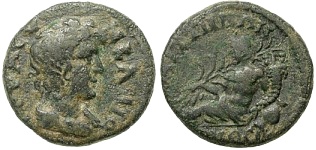

Saitta (or Saittai) was in eastern Lydia, in the triangle between the upper Hyllus river (modern Demirci Çayi) and the Hermus river (modern Sidaskale). Representations of the river gods are found on coins of the Imperial Period. The moon god Mên Akziottenos was honored, but Zeus, Dionysos, Aphrodite, Hygieia, Asklepios, Apollo, Kybele, and Herakles were also revered at Saitta. The town was a regional center for textile production. Hadrian probably visited in 124 A.D. In the city, In the Christian era Saittai was attached to the Archbishopric of Sardeis.RP82035. Bronze AE 20, GRPC Lydia 14; SNG Cop 398; SNGvA 3088; SNG Righetti 1066; SNG Tub 3762; BMC Lydia p. 216, 25; Weber 6889, VF, weight 5.210 g, maximum diameter 20.3 mm, die axis 180o, Saitta (Sidaskale, Turkey) mint, c. 200 - 275 A.D.; obverse IEPA CVN KΛHTOC, draped bust of the Senate right; reverse CAITTHNΩN EΠMOC, river-god Hermos reclining left, holding reed and cornucopia, resting elbow on inverted vase from which water flows; SOLD
Severus Alexander, 13 March 222 - March 235 A.D., Saitta, Lydia
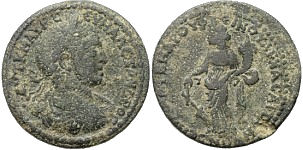

Saitta (or Saittai) was in eastern Lydia, in the triangle between the upper Hyllus river (modern Demirci Çayı) and the Hermus river (modern Sidaskale). Representations of the river gods are found on coins of the Imperial Period. The moon god Mên Akziottenos was honored, but Zeus, Dionysos, Aphrodite, Hygieia, Asklepios, Apollo, Kybele, and Herakles were also revered at Saitta. The town was a regional center for textile production. Hadrian probably visited in 124 A.D. In the city, In the Christian era Saittai was attached to the Archbishopric of Sardeis.RP38987. Bronze AE 30, GRPC Lydia p. 276, 136; SNGvA 3101; Waddington 5190; Imhoof-Blumer LS -; BMC Lydia -; SNG Cop -, aVF, weight 12.675 g, maximum diameter 29.8 mm, die axis 180o, Saitta (Sidaskale, Turkey) mint, 13 Mar 222 - Mar 235 A.D.; obverse AVT K M AYP CEVH AΛEΞANΔPOC, laureate, draped, and cuirassed bust right, seen from behind; reverse EΠI M KΛ Φ BHΣ POYΦEINO APX A CAITTHNΩN, Tyche standing half left, head left, wearing polos on head, rudder in right hand, cornucopia in left hand; very rare; SOLD
Saitta, Lydia, c. 193 - 268 A.D.


Saitta (or Saittai) was in eastern Lydia, in the triangle between the upper Hyllus river (modern Demirci Çayı) and the Hermus river (modern Sidaskale). Representations of the river gods are found on coins of the Imperial Period. The moon god Mên Akziottenos was honored, but Zeus, Dionysos, Aphrodite, Hygieia, Asklepios, Apollo, Kybele, and Herakles were also revered at Saitta. The town was a regional center for textile production. Hadrian probably visited in 124 A.D. In the city, In the Christian era Saittai was attached to the Archbishopric of Sardeis.RP91828. Bronze AE 28, SNG Leypold 1151 (same dies); GRPC Lydia 41; BMC Lydia p. 217, 29; SNG Cop 399; SNGvA 8244; Waddington 5169, F, light corrosion/porosity, scratches, edge cracks, weight 8.121 g, maximum diameter 27.6 mm, die axis 180o, Saitta (Sidaskale, Turkey) mint, c. 193 - 268 A.D.; obverse IEPA-CVN KΛHT-OC, draped bust of the Roman Senate right; reverse CAITT-HNΩN, Athena standing facing, head left, wearing crested Corinthian helmet and chiton, owl(?) in right hand, grounded shield and spear in left hand; SOLD

You are viewing a SOLD items page.
Click here to return to the page with AVAILABLE items.
The sale price for a sold item is the private information of the buyer and will not be provided.



REFERENCES
Page created in 1.265 seconds.






